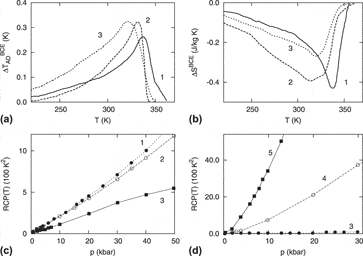Crossref Citations
This article has been cited by the following publications. This list is generated based on data provided by
Crossref.
Liu, Yang
Wei, Jie
Janolin, Pierre-Eymeric
Infante, Ingrid C.
Lou, Xiaojie
and
Dkhil, Brahim
2014.
Giant room-temperature barocaloric effect and pressure-mediated electrocaloric effect in BaTiO3 single crystal.
Applied Physics Letters,
Vol. 104,
Issue. 16,
Flerov, I. N.
Mikhaleva, E. A.
Gorev, M. V.
and
Kartashev, A. V.
2015.
Caloric and multicaloric effects in oxygen ferroics and multiferroics.
Physics of the Solid State,
Vol. 57,
Issue. 3,
p.
429.
Mikhaleva, Ekateina
Eremin, Evgeniy
Flerov, Igor
Kartashev, Andrey
Sablina, Klara
and
Mikhashenok, Nataly
2015.
Magnetization and magnetocaloric effect in La0.7Pb0.3MnO3 ceramics and 0.85(La0.7Pb0.3MnO3)–0.15(PbTiO3) composite.
Journal of Materials Research,
Vol. 30,
Issue. 2,
p.
278.
Mikhaleva, E. A.
Flerov, I. N.
Gorev, M. V.
and
Shabanov, A. V.
2018.
Effect of Sequential Heat Impacts on the Formation of a Stable State of the xLPM–(1 – x)PT Multiferroic Composites.
Physics of the Solid State,
Vol. 60,
Issue. 12,
p.
2524.
Mikhaleva, E. A.
Flerov, I. N.
Kartashev, A. V.
Gorev, M. V.
Molokeev, M. S.
Korotkov, L. N.
and
Rysiakiewicz-Pasek, E.
2018.
Specific Heat and Thermal Expansion of Triglycine Sulfate–Porous Glass Nanocomposites.
Physics of the Solid State,
Vol. 60,
Issue. 7,
p.
1338.
Gorev, Mikhail V.
Mikhaleva, Ekaterina A.
Flerov, Igor N.
and
Bogdanov, Evgeniy V.
2019.
Conventional and inverse barocaloric effects in ferroelectric NH4HSO4.
Journal of Alloys and Compounds,
Vol. 806,
Issue. ,
p.
1047.
Zhao, Z. R.
Jing, T.
Wang, G. F.
Li, Y. F.
Ma, Q.
and
Zhang, X. F.
2019.
Comparative Study of Magnetocaloric Effect in La0.67Ca0.20Sr0.13MnO3 Manganite Prepared by Sol-Gel Method and Spark Plasma Sintering.
Journal of Superconductivity and Novel Magnetism,
Vol. 32,
Issue. 4,
p.
993.
Amirov, Abdulkarim A.
Anokhin, Alexander S.
Talanov, Mikhail V.
Sokolovskiy, Vladimir V.
Kutzhanov, Magzhan. K.
Huang, Houbing
Reznichenko, Larisa A.
Es’kov, Andrey V.
and
Aliev, Akhmed M.
2023.
Multicaloric Effect in 0–3-Type MnAs/PMN–PT Composites.
Journal of Composites Science,
Vol. 7,
Issue. 9,
p.
400.
Hadouch, Youness
Mezzane, Daoud
Amjoud, M. 'barek
Uršič, Hana
Lahmar, Abdelilah
Rozic, Brigita
Lukyanchuk, Igor
Kutnjak, Zdravko
and
El Marssi, Mimoun
2025.
Current advances in magnetoelectric composites with various interphase connectivity types.
Sustainable Energy & Fuels,
Vol. 9,
Issue. 8,
p.
1957.
